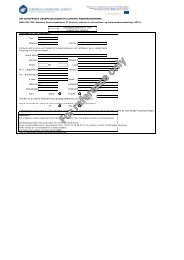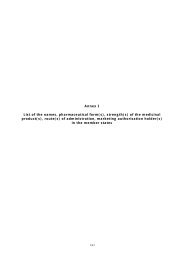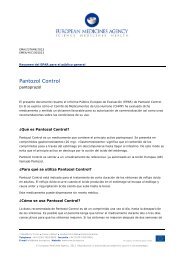Depocyte, INN-cytarabine - European Medicines Agency - Europa
Depocyte, INN-cytarabine - European Medicines Agency - Europa
Depocyte, INN-cytarabine - European Medicines Agency - Europa
Create successful ePaper yourself
Turn your PDF publications into a flip-book with our unique Google optimized e-Paper software.
ANNEX 1<br />
SUMMARY OF PRODUCT CHARACTERISTICS<br />
1
1. NAME OF THE MEDICINAL PRODUCT<br />
DepoCyte 50 mg suspension for injection<br />
2. QUALITATIVE AND QUANTITATIVE COMPOSITION<br />
One ml of suspension contains 10 mg <strong>cytarabine</strong>.<br />
Each 5 ml vial contains 50 mg <strong>cytarabine</strong>.<br />
For a full list of excipients, see section 6.1.<br />
3. PHARMACEUTICAL FORM<br />
Suspension for injection.<br />
White to off-white suspension.<br />
4. CLINICAL PARTICULARS<br />
4.1 Therapeutic indications<br />
Intrathecal treatment of lymphomatous meningitis. In the majority of patients such treatment will be<br />
part of symptomatic palliation of the disease.<br />
4.2 Posology and method of administration<br />
DepoCyte should be administered only under the supervision of a physician experienced in the use of<br />
cancer chemotherapeutic agents.<br />
Posology<br />
Adults and the elderly<br />
For the treatment of lymphomatous meningitis, the dose for adults is 50 mg (one vial) administered<br />
intrathecally (lumbar puncture or intraventricularly via an Ommaya reservoir). The following regimen<br />
of induction, consolidation and maintenance therapy is recommended:<br />
Induction therapy: 50 mg administered every 14 days for 2 doses (weeks 1 and 3).<br />
Consolidation therapy: 50 mg administered every 14 days for 3 doses (weeks 5, 7 and 9) followed by<br />
an additional dose of 50 mg at week 13.<br />
Maintenance therapy: 50 mg administered every 28 days for 4 doses (weeks 17, 21, 25 and 29).<br />
Paediatric population<br />
Safety and efficacy in children have not been adequately demonstrated (see section 5.1). DepoCyte is<br />
not recommended for use in children and adolescents until further data become available.<br />
Method of administration<br />
DepoCyte is to be administered by slow injection over a period of 1-5 minutes directly into the<br />
cerebrospinal fluid (CSF) via either an intraventricular reservoir or by direct injection into the lumbar<br />
sac. Following administration by lumbar puncture, it is recommended that the patient should be<br />
2
instructed to lie flat for one hour. All patients should be started on dexamethasone 4 mg twice daily<br />
either orally or intravenously for 5 days beginning on the day of injection of DepoCyte.<br />
DepoCyte must not be administered by any other route of administration.<br />
DepoCyte must be used as supplied; it must not be diluted (see section 6.2).<br />
Patients should be observed by the physician for immediate toxic reactions.<br />
If neurotoxicity develops, the dose should be reduced to 25 mg. If it persists, treatment with<br />
DepoCyte should be discontinued.<br />
4.3 Contraindications<br />
Hypersensitivity to the active substance or to any of the excipients.<br />
Patients with active meningeal infection.<br />
4.4 Special warnings and precautions for use<br />
Patients receiving DepoCyte should be concurrently treated with corticosteroids (e.g. dexamethasone)<br />
to mitigate the symptoms of arachnoiditis (see section 4.8), which is a very common adverse reaction.<br />
Arachnoiditis is a syndrome manifested primarily by nausea, vomiting, headache and fever. If left<br />
untreated, chemical arachnoiditis may be fatal.<br />
Patients should be informed about the expected adverse reactions of headache, nausea, vomiting and<br />
fever, and about the early signs and symptoms of neurotoxicity. The importance of concurrent<br />
dexamethasone administration should be emphasised at the initiation of each cycle of DepoCyte<br />
treatment. Patients should be instructed to seek medical attention if signs or symptoms of<br />
neurotoxicity develop, or if oral dexamethasone is not well tolerated.<br />
Cytarabine, when administered intrathecally, has been associated with nausea, vomiting and serious<br />
central nervous system toxicity which can lead to a permanent deficit, this includes blindness,<br />
myelopathy and other neurological toxicity.<br />
Administration of DepoCyte in combination with other neurotoxic chemotherapeutic agents or with<br />
cranial/spinal irradiation may increase the risk of neurotoxicity.<br />
Infectious meningitis may be associated with intrathecal administration. Hydrocephalus has also been<br />
reported, possibly precipitated by arachnoiditis.<br />
Blockage or reduction of CSF flow may result in increased free <strong>cytarabine</strong> concentrations in the CSF<br />
with increased risk of neurotoxicity. Therefore, as with any intrathecal cytotoxic therapy,<br />
consideration should be given to the need for assessment of CSF flow before treatment is started.<br />
Although significant systemic exposure to free <strong>cytarabine</strong> is not expected following intrathecal<br />
treatment, some effects on bone marrow function cannot be excluded. Systemic toxicity due to<br />
intravenous administration of <strong>cytarabine</strong> consists primarily of bone marrow suppression with<br />
leucopenia, thrombocytopenia and anaemia. Therefore monitoring of the haemopoietic system is<br />
advised.<br />
Anaphylactic reactions following intravenous administration of free <strong>cytarabine</strong> have been rarely<br />
reported.<br />
Since DepoCyte’s particles are similar in size and appearance to white blood cells, care must be taken<br />
in interpreting CSF examination following administration.<br />
3
4.5 Interaction with other medicinal products and other forms of interaction<br />
No definite interactions between DepoCyte delivered intrathecally and other medicinal products have<br />
been established.<br />
Concomitant administration of DepoCyte with other antineoplastic agents administered by the<br />
intrathecal route has not been studied.<br />
Intrathecal co-administration of <strong>cytarabine</strong> with other cytotoxic agents may increase the risk of<br />
neurotoxicity.<br />
4.6 Fertility, pregnancy and lactation<br />
Pregnancy<br />
Teratology studies in animals have not been conducted with DepoCyte and there are no adequate and<br />
well controlled studies in pregnant women.<br />
Cytarabine, the active ingredient in DepoCyte, can cause foetal harm when administered systemically<br />
during pregnancy, mainly during the first trimester. Concern for foetal harm following intrathecal<br />
DepoCyte administration however, is low because systemic exposure to <strong>cytarabine</strong> is negligible.<br />
Despite the low apparent risk women of childbearing potential should not receive treatment until<br />
pregnancy is excluded and should be advised to use a reliable contraceptive method.<br />
Given that <strong>cytarabine</strong> has a mutagenic potential which could induce chromosomal damage in the<br />
human spermatozoa, males undergoing DepoCyte treatment and their partner should be advised to use<br />
a reliable contraceptive method.<br />
Breast-feeding<br />
It is not known whether <strong>cytarabine</strong> is excreted in human milk following intrathecal administration.<br />
The systemic exposure to free <strong>cytarabine</strong> following intrathecal treatment with DepoCyte was<br />
negligible. Because of possible excretion in human milk and because of the potential for serious<br />
adverse reactions in nursing infants, the use of DepoCyte is not recommended in breast-feeding<br />
women.<br />
Fertility<br />
Fertility studies to assess the reproductive toxicity of DepoCyte have not been conducted. Because the<br />
systemic exposure to free <strong>cytarabine</strong> following intrathecal treatment with DepoCyte is negligible, the<br />
risk of impaired fertility is likely to be low (see section 5.3).<br />
4.7 Effects on ability to drive and use machines<br />
There have been no reports explicitly relating to effects of DepoCyte treatment on the ability to drive<br />
or use machines. However, on the basis of reported adverse reactions, patients should be advised<br />
against driving or using machines during treatment.<br />
4.8 Undesirable effects<br />
In Phase 1-4 studies the most commonly reported adverse reactions associated with DepoCyte were<br />
headache (23%), arachnoiditis (16%), pyrexia (14%), weakness (13%), nausea (13%), vomiting<br />
(12%), confusion (11%), diarrhoea (11%), thrombocytopenia (10%), and fatigue (6%).<br />
For Phase 1-4 studies in patients with lymphomatous meningitis receiving either DepoCyte or<br />
<strong>cytarabine</strong> adverse reactions are listed by MedDRA body system organ class and by frequency (Very<br />
common (≥1/10); and Common (≥1/100 to < 1/10); uncommon (≥1/1,000 to
to
Table 2: Adverse reactions possibly reflecting neurotoxicities in Phase II, III, and IV patients<br />
receiving DepoCyte 50 mg (n = 99 cycles) or <strong>cytarabine</strong> ( n = 84 cycles)<br />
Psychiatric disorders<br />
DepoCyte Common: somnolence<br />
Cytarabine Common: somnolence<br />
Nervous system disorders<br />
DepoCyte Common: cauda equina syndrome, convulsions,<br />
cranial nerve palsies, hypoesthesia, myelopathy,<br />
paresthesia, hemiplegia, numbness<br />
Cytarabine Common: cauda equina syndrome, convulsions,<br />
cranial nerve palsies, hypoesthesia, myelopathy,<br />
paresthesia, hemiplegia, numbness<br />
Eye disorders<br />
DepoCyte Common: visual disturbances, blindness<br />
Cytarabine Common: visual disturbances, blindness<br />
Ear and labyrinth disorders<br />
DepoCyte Common: deafness<br />
Cytarabine Common: deafness<br />
Gastrointestinal disorders<br />
DepoCyte Common: impaired bowel control<br />
Cytarabine Common: impaired bowel control<br />
Renal and urinary disorders<br />
DepoCyte Common: urinary incontinence<br />
Cytarabine Common: urinary incontinence<br />
General disorders and administration site<br />
conditions<br />
DepoCyte Very Common: weakness<br />
Common: pain<br />
Cytarabine Very Common: weakness<br />
Common: pain<br />
All patients receiving DepoCyte should be treated concurrently with dexamethasone to mitigate the<br />
symptoms of arachnoiditis. Toxic effects may be related to a single dose or to cumulative doses.<br />
Because toxic effects can occur at any time during therapy (although they are most likely within 5<br />
days of administration), patients receiving DepoCyte therapy should be monitored continuously for the<br />
development of neurotoxicity. If patients develop neurotoxicity, subsequent doses of DepoCyte<br />
should be reduced, and treatment should be discontinued if toxicity persists.<br />
Arachnoiditis, a very common adverse reaction associated with DepoCyte, is a syndrome manifested<br />
by several adverse reactions. The incidence of these adverse reactions, possibly reflecting meningeal<br />
irritation, are headache (24%), nausea (18%), vomiting (17%), pyrexia (12%), neck stiffness (3%),<br />
neck pain (4%), back pain (7%), meningism (
Table 3: Adverse reactions possibly reflecting meningeal irritation in Phase II, III, and IV<br />
patients<br />
Nervous system disorders<br />
DepoCyte (n = 929 cycles) Very common: headache<br />
Common: convulsions, hydrocephalus acquired,<br />
CSF pleocytosis<br />
Uncommon: meningism<br />
Methotrexate (n = 258 cycles)<br />
Very common: headache<br />
Common: convulsions, hydrocephalus acquired,<br />
meningism<br />
Cytarabine (n = 99 cycles) Very common: headache<br />
Common: convulsions, meningism<br />
Gastrointestinal disorders<br />
DepoCyte (n = 929 cycles) Very common: vomiting, nausea<br />
Methotrexate (n = 258 cycles) Very common: vomiting, nausea<br />
Cytarabine (n = 99 cycles) Very common: vomiting, nausea<br />
Musculoskeletal and connective tissue<br />
disorders<br />
DepoCyte (n = 929 cycles) Common: back pain, neck pain, neck stiffness<br />
Methotrexate (n = 258 cycles) Common: back pain, neck pain<br />
Uncommon: neck stiffness<br />
Cytarabine (n = 99 cycles) Common: back pain, neck pain, neck stiffness<br />
General disorders and administration site<br />
conditions<br />
DepoCyte (n = 929 cycles) Very common: pyrexia<br />
Methotrexate (n = 258 cycles) Common: pyrexia<br />
Cytarabine (n = 99 cycles) Very common: pyrexia<br />
*Cycle length was 2 weeks during which the patient received either 1 dose of DepoCyte or 4 doses of<br />
<strong>cytarabine</strong> or methotrexate. Cytarabine and methotrexate patients not completing all 4 doses are<br />
counted as a fraction of a cycle.<br />
Investigations<br />
Transient elevations in CSF protein and white blood cells have been observed in patients following<br />
DepoCyte administration, and have also been noted after intrathecal treatment with methotrexate or<br />
<strong>cytarabine</strong>. These reactions have been reported mainly from post-marketing experience with<br />
DepoCyte as spontaneous case reports. Because these reactions are reported from a population of<br />
uncertain size, it is not possible to reliably estimate their frequency.<br />
4.9 Overdose<br />
No overdoses with DepoCyte have been reported. An overdose with DepoCyte may be associated<br />
with severe arachnoiditis including encephalopathy.<br />
In an early uncontrolled study without dexamethasone prophylaxis, single doses up to 125 mg were<br />
administered. One patient at the 125 mg dose level died of encephalopathy 36 hours after receiving<br />
DepoCyte intraventricularly. This patient, however, was also receiving concomitant whole brain<br />
irradiation and had previously received intraventricular methotrexate.<br />
There is no antidote for intrathecal DepoCyte or unencapsulated <strong>cytarabine</strong> released from DepoCyte.<br />
Exchange of cerebrospinal fluid with isotonic sodium chloride solution has been carried out in a case<br />
of intrathecal overdose of free <strong>cytarabine</strong> and such a procedure may be considered in the case of<br />
DepoCyte overdose. Management of overdose should be directed at maintaining vital functions.<br />
7
5. PHARMACOLOGICAL PROPERTIES<br />
5.1 Pharmacodynamic properties<br />
Pharmacotherapeutic group: Antimetabolites, pyrimidine analogues, ATC code L01BC01<br />
DepoCyte is a sustained-release formulation of <strong>cytarabine</strong>, designed for direct administration into the<br />
cerebrospinal fluid (CSF).<br />
Cytarabine is a cell-cycle phase specific antineoplastic agent, affecting cells only during the S-phase<br />
of cell division. Intracellularly, <strong>cytarabine</strong> is converted into <strong>cytarabine</strong>-5’-triphosphate (ara-CTP),<br />
which is the active metabolite. The mechanism of action is not completely understood, but it appears<br />
that ara-CTP acts primarily through inhibition of DNA synthesis. Incorporation into DNA and RNA<br />
may also contribute to <strong>cytarabine</strong> cytotoxicity. Cytarabine is cytotoxic to a wide variety of<br />
proliferating mammalian cells in culture.<br />
For cell-cycle phase specific antimetabolites the duration of exposure of neoplastic cells to cytotoxic<br />
concentrations is an important determination of efficacy.<br />
In vitro studies, examining more than 60 cell lines, demonstrated that the median <strong>cytarabine</strong><br />
concentration resulting in 50% growth inhibition (IC50) was approximately 10 μM (2.4 μg/ml) for two<br />
days of exposure and 0.1 μM (0.024 μg/ml) for 6 days of exposure. The studies also demonstrated<br />
susceptibility of many solid tumour cell lines to <strong>cytarabine</strong>, particularly after longer periods of<br />
exposure to <strong>cytarabine</strong>.<br />
In an open-label, active-controlled, multicentre clinical study, 35 patients with lymphomatous<br />
meningitis (with malignant cells found on CSF cytology) were randomised to intrathecal therapy with<br />
either DepoCyte (n=18) or unencapsulated <strong>cytarabine</strong> (n=17). During the 1 month Induction phase of<br />
treatment, DepoCyte was administered intrathecally as 50 mg every 2 weeks, and unencapsulated<br />
<strong>cytarabine</strong> as 50 mg twice a week. Patients who did not respond discontinued protocol treatment after<br />
4 weeks. Patients who achieved a response (defined as clearing of the CSF of malignant cells in the<br />
absence of progression of neurological symptoms) went on to receive Consolidation and Maintenance<br />
therapy for up to 29 weeks.<br />
Responses were observed in 13/18 (72%, 95% confidence intervals: 47, 90) of DepoCyte patients<br />
versus 3/17 (18% patients, 95% confidence intervals: 4, 43) in the unencapsulated <strong>cytarabine</strong> arm. A<br />
statistically significant association between treatment and response was observed (Fisher’s exact test<br />
p-value = 0.002). The majority of DepoCyte patients went on beyond Induction to receive additional<br />
therapy. DepoCyte patients received a median of 5 cycles (doses) per patient (range 1 to 10 doses)<br />
with a median time on therapy of 90 days (range 1 to 207 days).<br />
No statistically significant differences were noted in secondary endpoints such as duration of response,<br />
progression-free survival, neurological signs and symptoms, Karnofsky performance status, quality of<br />
life and overall survival. Median progression-free survival (defined as time to neurological<br />
progression or death) for all treated patients was 77 versus 48 days for DepoCyte versus<br />
unencapsulated <strong>cytarabine</strong>, respectively. The proportion of patients alive at 12 months was 24% for<br />
DepoCyte versus 19% for unencapsulated <strong>cytarabine</strong>.<br />
In an open-label non-comparative dose escalation study in 18 paediatric patients (4 to 19 years) with<br />
leukaemic meningitis or neoplastic meningitis due to primary brain tumour, an intrathecal dose of<br />
35 mg was identified as the maximum tolerated dose.<br />
5.2 Pharmacokinetic properties<br />
Analysis of the available pharmacokinetic data shows that following intrathecal DepoCyte<br />
administration in patients, either via the lumbar sac or by intraventricular reservoir, peaks of free<br />
<strong>cytarabine</strong> were observed within 5 hours in both the ventricle and lumbar sac. These peaks were<br />
8
followed by a biphasic elimination profile consisting of an initial sharp decline and subsequent slow<br />
decline with a terminal phase half-life of 100 to 263 hours over a dose-range of 12.5 mg to 75 mg. In<br />
contrast, intrathecal administration of 30 mg free <strong>cytarabine</strong> has shown a biphasic CSF concentration<br />
profile with a terminal phase half-life of about 3.4 hours.<br />
Pharmacokinetic parameters of DepoCyte (75 mg) in neoplastic meningitis patients in whom the<br />
medicinal product was administered either intraventricularly or by lumbar puncture suggest that<br />
exposure to the active substance in the ventricular or lumbar spaces is similar regardless of the route of<br />
administration. In addition, compared with free <strong>cytarabine</strong>, the formulation increases the biological<br />
half-life by a factor of 27 to 71 depending upon the route of administration and the compartment<br />
sampled. Encapsulated <strong>cytarabine</strong> concentrations and the counts of the lipid particles in which the<br />
<strong>cytarabine</strong> is encapsulated in followed a similar distribution pattern. AUCs of free and encapsulated<br />
<strong>cytarabine</strong> after ventricular injection of DepoCyte appeared to increase linearly with increasing dose,<br />
indicating that the release of <strong>cytarabine</strong> from DepoCyte and the pharmacokinetics of <strong>cytarabine</strong> are<br />
linear in human CSF.<br />
The transfer rate of <strong>cytarabine</strong> from CSF to plasma is slow and the conversion to uracil arabinoside<br />
(ara-U), the inactive metabolite, in the plasma is fast. Systemic exposure to <strong>cytarabine</strong> was<br />
determined to be negligible following intrathecal administration of 50 mg and 75 mg of DepoCyte.<br />
Biotransformation and elimination<br />
The primary route of elimination of <strong>cytarabine</strong> is metabolism to the inactive compound ara-U, (1-β-Darabinofuranosyluracil<br />
or uracil arabinoside) followed by urinary excretion of ara-U. In contrast with<br />
systemically administered <strong>cytarabine</strong> which is rapidly metabolised to ara-U, conversion to ara-U in the<br />
CSF is negligible after intrathecal administration because of the significantly lower cytidine deaminase<br />
activity in the CNS tissues and CSF. The CSF clearance rate of <strong>cytarabine</strong> is similar to the CSF bulk<br />
flow rate of 0.24 ml/min.<br />
The distribution and clearance of <strong>cytarabine</strong> and of the predominant phospholipid component of the<br />
lipid particle (DOPC) following intrathecal administration of DepoCyte was evaluated in rodents.<br />
Radiolabels for <strong>cytarabine</strong> and DOPC were distributed rapidly throughout the neuraxis. More than<br />
90% of <strong>cytarabine</strong> was excreted by day 4 and an additional 2.7% by 21 days. The results suggest that<br />
the lipid components undergo hydrolysis and are largely incorporated in the tissues following<br />
breakdown in the intrathecal space.<br />
5.3 Preclinical safety data<br />
A review of the toxicological data available for the constituent lipids (DOPC and DPPG) or similar<br />
phospholipids to those in DepoCyte indicates that such lipids are well tolerated in various animal<br />
species even when administered for prolonged periods at doses in the g/kg range.<br />
The results of acute and subacute toxicity studies performed in monkeys suggested that intrathecal<br />
DepoCyte was tolerated up to a dose of 10 mg (comparable to a human dose of 100 mg). Slight to<br />
moderate inflammation of the meninges in the spinal cord and brain and/or astrocytic activation were<br />
observed in animals receiving intrathecal DepoCyte. These changes were believed to be consistent<br />
with the toxic effects of other intrathecal agents such as unencapsulated <strong>cytarabine</strong>. Similar changes<br />
(generally described as minimal to slight) were also observed in some animals receiving DepoFoam<br />
alone (DepoCyte vesicles without <strong>cytarabine</strong>) but not in sodium chloride solution control animals.<br />
Mouse, rat and dog studies have shown that free <strong>cytarabine</strong> is highly toxic for the haemopoietic<br />
system.<br />
No carcinogenicity, mutagenicity or impairment of fertility studies have been conducted with<br />
DepoCyte. The active ingredient, <strong>cytarabine</strong>, was mutagenic in in vitro tests and was clastogenic in<br />
vitro (chromosome aberrations and sister chromatid exchange in human leukocytes) and in vivo<br />
(chromosome aberrations and sister chromatid exchange assay in rodent bone marrow, mouse<br />
micronucleus assay). Cytarabine caused the transformation of hamster embryo cells and rat H43 cells<br />
in vitro. Cytarabine was clastogenic to meiotic cells; a dose-dependent increase in sperm-head<br />
9
abnormalities and chromosomal aberrations occurred in mice given intraperitoneal (i.p.) <strong>cytarabine</strong>.<br />
No studies assessing the impact of <strong>cytarabine</strong> on fertility are available in the literature. Because the<br />
systemic exposure to free <strong>cytarabine</strong> following intrathecal treatment with DepoCyte was negligible,<br />
the risk of impaired fertility is likely to be low.<br />
6. PHARMACEUTICAL PARTICULARS<br />
6.1 List of excipients<br />
Cholesterol<br />
Triolein<br />
Dioleoylphosphatidylcholine (DOPC)<br />
Dipalmitoylphosphatidylglycerol (DPPG)<br />
Sodium chloride<br />
Water for injections<br />
6.2 Incompatibilities<br />
No formal assessments of pharmacokinetic drug-drug interactions between DepoCyte and other agents<br />
have been conducted. DepoCyte should not be diluted or mixed with any other medicinal products, as<br />
any change in concentration or pH may affect the stability of the microparticles.<br />
6.3 Shelf life<br />
18 months.<br />
After first opening: from a microbiological point of view, the product should be used immediately. If<br />
not used immediately, in-use storage times and conditions prior to use are the responsibility of the user<br />
and would normally not be longer than 4 hours at 18 to 22°C.<br />
6.4 Special precautions for storage<br />
Store in a refrigerator (2°C - 8°C).<br />
Do not freeze.<br />
6.5 Nature and contents of container<br />
Type I glass vial closed with a fluororesin faced butyl rubber stopper and sealed with an aluminium<br />
flip-off seal containing 50 mg <strong>cytarabine</strong> in 5 ml suspension.<br />
DepoCyte is supplied in individual cartons each containing one single-dose vial.<br />
6.6 Special precautions for disposal and other handling<br />
Preparation of DepoCyte<br />
Given its toxic nature, special precautions should be taken in handling DepoCyte. See ‘Precautions<br />
for the handling and disposal of DepoCyte’ below.<br />
Vials should be allowed to warm to room temperature (18°C -22°C) for a minimum of 30 minutes and<br />
be gently inverted to resuspend the particles immediately prior to withdrawal from the vial. Vigorous<br />
shaking should be avoided. No further reconstitution or dilution is required.<br />
10
DepoCyte administration<br />
DepoCyte must only be administered by the intrathecal route.<br />
DepoCyte should be withdrawn from the vial immediately before administration. Since it is a single<br />
use vial and does not contain any preservative, the medicinal product should be used within 4 hours of<br />
withdrawal from the vial. Unused medicinal product must be discarded and not used subsequently.<br />
DepoCyte must not be mixed with any other medicinal products (see section 6.2). The suspension<br />
must not be diluted.<br />
In-line filters must not be used when administering DepoCyte. DepoCyte is administered directly into<br />
the CSF via an intraventricular reservoir or by direct injection into the lumbar sac. DepoCyte should<br />
be injected slowly over a period of 1-5 minutes. Following administration by lumbar puncture, the<br />
patient should be instructed to lie flat for one hour. Patients should be observed by the physician for<br />
immediate toxic reactions.<br />
All patients should be started on dexamethasone 4 mg twice daily either orally or intravenously for 5<br />
days beginning on the day of DepoCyte injection.<br />
Precautions for the handling and disposal of DepoCyte<br />
The following protective recommendations are given due to the toxic nature of this substance:<br />
• personnel should be trained in good technique for handling anticancer agents;<br />
• male and female staff who are trying to conceive and female staff who are pregnant should be<br />
excluded from working with the substance;<br />
• personnel must wear protective clothing: goggles, gowns, disposable gloves and masks;<br />
• a designated area should be defined for preparation (preferably under a laminar flow system).<br />
The work surface should be protected by disposable, plastic backed, absorbent paper;<br />
• all items used during administration or cleaning should be placed in high risk, waste-disposal<br />
bags for high temperature incineration;<br />
• in the event of accidental contact with the skin, exposed areas should be washed immediately<br />
with soap and water;<br />
• in the event of accidental contact with the mucous membranes, exposed areas should be treated<br />
immediately by copious lavage with water; medical attention should be sought.<br />
7. MARKETING AUTHORISATION HOLDER<br />
Pacira Limited<br />
3 Glory Park Avenue<br />
Wooburn Green<br />
High Wycombe<br />
Buckinghamshire<br />
HP10 0DF<br />
United Kingdom<br />
8. MARKETING AUTHORISATION NUMBER<br />
EU/1/01/187/001<br />
9. DATE OF FIRST AUTHORISATION/RENEWAL OF THE AUTHORISATION<br />
Date of first authorisation: 11 July 2001<br />
Date of latest renewal: 11 July 2011<br />
11
10. DATE OF REVISION OF THE TEXT<br />
Detailed information on this product is available on the website of the <strong>European</strong> <strong>Medicines</strong> <strong>Agency</strong><br />
http://www.ema.europa.eu.<br />
12
ANNEX II<br />
A. MANUFACTURING AUTHORISATION HOLDER<br />
RESPONSIBLE FOR BATCH RELEASE<br />
B. CONDITIONS OF THE MARKETING AUTHORISATION<br />
13
A MANUFACTURING AUTHORISATION HOLDER RESPONSIBLE FOR BATCH<br />
RELEASE<br />
Name and address of the manufacturer responsible for batch release<br />
Almac Pharma Services Limited<br />
20 Seagoe Industrial Estate<br />
Craigavon, Co Armagh<br />
BT63 5QD<br />
United Kingdom<br />
B CONDITIONS OF THE MARKETING AUTHORISATION<br />
• CONDITIONS OR RESTRICTIONS REGARDING SUPPLY AND USE IMPOSED ON<br />
THE MARKETING AUTHORISATION HOLDER<br />
Medicinal product subject to restricted medical prescription (See Annex I: Summary of Product<br />
Characteristics, section 4.2).<br />
• CONDITIONS OR RESTRICTIONS WITH REGARD TO THE SAFE AND<br />
EFFECTIVE USE OF THE MEDICINAL PRODUCT<br />
Not applicable.<br />
• OTHER CONDITIONS<br />
The Marketing Authorisation Holder should submit 2-yearly PSURs until otherwise specified by the<br />
CHMP.<br />
14
ANNEX III<br />
LABELLING AND PACKAGE LEAFLET<br />
15
A. LABELLING<br />
16
PARTICULARS TO APPEAR ON THE OUTER PACKAGING<br />
BOX<br />
1. NAME OF THE MEDICINAL PRODUCT<br />
DepoCyte 50 mg suspension for injection<br />
Cytarabine<br />
2. STATEMENT OF ACTIVE SUBSTANCE(S)<br />
Each vial contains 50 mg <strong>cytarabine</strong> (10 mg/ml).<br />
3. LIST OF EXCIPIENTS<br />
Also contains: cholesterol, triolein, dioleoylphosphatidylcholine, dipalmitoylphosphatidylglycerol,<br />
sodium chloride, water for injections.<br />
4. PHARMACEUTICAL FORM AND CONTENTS<br />
Suspension for injection.<br />
One 5 ml vial.<br />
5. METHOD AND ROUTE(S) OF ADMINISTRATION<br />
Intrathecal use.<br />
Read the package leaflet before use.<br />
6. SPECIAL WARNING THAT THE MEDICINAL PRODUCT MUST BE STORED OUT<br />
OF THE REACH AND SIGHT OF CHILDREN<br />
Keep out of the reach and sight of children.<br />
7. OTHER SPECIAL WARNING(S), IF NECESSARY<br />
8. EXPIRY DATE<br />
EXP<br />
9. SPECIAL STORAGE CONDITIONS<br />
Store in a refrigerator (2ºC - 8ºC).<br />
Do not freeze.<br />
17
10. SPECIAL PRECAUTIONS FOR DISPOSAL OF UNUSED MEDICINAL PRODUCTS<br />
OR WASTE MATERIALS DERIVED FROM SUCH MEDICINAL PRODUCTS, IF<br />
APPROPRIATE<br />
11. NAME AND ADDRESS OF THE MARKETING AUTHORISATION HOLDER<br />
Pacira Limited<br />
3 Glory Park Avenue<br />
Wooburn Green<br />
High Wycombe<br />
Buckinghamshire<br />
HP10 0DF<br />
United Kingdom<br />
12. MARKETING AUTHORISATION NUMBER(S)<br />
EU/1/01/187/001<br />
13. BATCH NUMBER<br />
Lot<br />
14. GENERAL CLASSIFICATION FOR SUPPLY<br />
Medicinal product subject to medical prescription.<br />
15. INSTRUCTIONS ON USE<br />
16. INFORMATION IN BRAILLE<br />
Justification for not including Braille accepted.<br />
18
MINIMUM PARTICULARS TO APPEAR ON SMALL IMMEDIATE PACKAGING UNITS<br />
VIAL LABEL<br />
1. NAME OF THE MEDICINAL PRODUCT AND ROUTE(S) OF ADMINISTRATION<br />
DepoCyte 50 mg suspension for injection<br />
Cytarabine<br />
Intrathecal use<br />
2. METHOD OF ADMINISTRATION<br />
3. EXPIRY DATE<br />
EXP<br />
4. BATCH NUMBER<br />
Lot<br />
5. CONTENTS BY WEIGHT, BY VOLUME OR BY UNIT<br />
5 ml.<br />
6. OTHER<br />
19
B. PACKAGE LEAFLET<br />
20
PACKAGE LEAFLET: INFORMATION FOR THE USER<br />
DepoCyte 50 mg suspension for injection<br />
Cytarabine<br />
Read all of this leaflet carefully before you receive this medicine.<br />
- Keep this leaflet. You may need to read it again.<br />
- If you have further questions, ask your doctor.<br />
- If any of the side effects gets serious, or if you notice any side effects not listed in this leaflet,<br />
please tell your doctor.<br />
In this leaflet:<br />
1. What DepoCyte is and what it is given for<br />
2. Before you are given DepoCyte<br />
3. How DepoCyte is given<br />
4. Possible side effects<br />
5. How to store DepoCyte<br />
6. Further information<br />
1. WHAT DEPOCYTE IS AND WHAT IT IS GIVEN FOR<br />
DepoCyte is used to treat lymphomatous meningitis.<br />
Lymphomatous meningitis is a condition in which tumour cells have invaded the fluid or membranes<br />
that surround the brain and spinal cord.<br />
DepoCyte is used in adults to kill lymphoma tumour cells.<br />
2. BEFORE YOU ARE GIVEN DEPOCYTE<br />
DepoCyte should not be given<br />
- If you are allergic (hypersensitive) to <strong>cytarabine</strong> or any of the other ingredients.<br />
- If you have a meningeal infection.<br />
Take special care with DepoCyte<br />
Severe neurological side effects have been reported with the use of DepoCyte. Symptoms have<br />
included effects on the nervous system (e.g. convulsions, pain, numbness or tingling, blindness or<br />
visual disturbances). Your doctor will check for these symptoms regularly.<br />
Make sure you take as directed any dexamethasone tablets that you may have been prescribed, as they<br />
reduce the risk of unwanted effects caused by DepoCyte.<br />
If your side effects get worse or you notice any new side effects, tell your doctor.<br />
Taking other medicines<br />
Please tell your doctor if you are taking or have recently taken any other medicines, including<br />
medicines obtained without a prescription.<br />
Pregnancy and breast-feeding<br />
DepoCyte should not be given to pregnant women as it may harm an unborn child. Women of<br />
childbearing potential should use a reliable contraceptive method to avoid pregnancy whilst being<br />
treated with DepoCyte.<br />
Male patients undergoing DepoCyte treatment should use a reliable contraceptive method.<br />
21
Women should not breast-feed during treatment as DepoCyte may enter breast milk.<br />
Driving and using machines<br />
Do not drive during treatment.<br />
Do not operate any tools or machines during treatment.<br />
3. HOW DEPOCYTE IS GIVEN<br />
A qualified and experienced doctor or physician in the treatment of cancer will inject DepoCyte in the<br />
spinal fluid or lumber sac. DepoCyte must not be administered by any other way. Injections are given<br />
slowly over 1-5 minutes and you may be asked to lie flat for one hour afterwards.<br />
You will also be given dexamethasone, usually as tablets but possibly by intravenous injection for 5<br />
days after you receive each DepoCyte dose to help reduce any side effects which might occur.<br />
Before DepoCyte is used the vial should be warmed to room temperature (18°C – 22°C) for at least 30<br />
minutes. Just before withdrawing DepoCyte, the vial should be gently inverted to mix the particles<br />
evenly. It should not be shaken vigorously.<br />
Proper precautions should be taken for the handling and administration of a cytotoxic drug (proper<br />
handling technique, use of a suitable designated area, protective clothing, procedures to address risk of<br />
contamination). Staff who are pregnant or trying to conceive (male and female) should not work with<br />
DepoCyte. In the event of accidental contact with the mucous membranes, treat immediately by<br />
copious washing with water; medical attention should be sought.<br />
DepoCyte should be withdrawn from the vial immediately before administration; the medicinal<br />
product should be used within 4 hours of withdrawal from the vial. Unused medicinal product must be<br />
discarded and not used subsequently. DepoCyte must not be mixed with any other medicinal<br />
products. In-line filters must not be used when administering DepoCyte.<br />
DepoCyte must be used as supplied without further dilution. The dose for adults is 50 mg (one vial of<br />
DepoCyte).<br />
For the treatment of lymphomatous meningitis, DepoCyte is given according to the following<br />
schedules:<br />
Start-up treatment: one vial of DepoCyte (50 mg) administered every 14 days for 2 doses (weeks 1<br />
and 3).<br />
Follow-up treatment: one vial of DepoCyte (50 mg) administered every 14 days for 3 doses (weeks<br />
5, 7 and 9) followed by an additional dose at week 13.<br />
Maintenance treatment: one vial of DepoCyte (50 mg) administered every 28 days for 4 doses<br />
(weeks 17, 21, 25 and 29).<br />
If you are given more DepoCyte than you should<br />
The recommended dose will be given to you by the doctor or physician as necessary. There is no<br />
antidote for DepoCyte. Management of overdose should be directed at maintaining vital functions.<br />
4. POSSIBLE SIDE EFFECTS<br />
Like all medicines, DepoCyte can cause side effects, although not everybody gets them. Side effects<br />
may occur after each injection, usually within the first five days.<br />
22
Your doctor will discuss these with you and will explain the potential risks and benefits of your<br />
treatment.<br />
The frequency of possible side effects listed below is defined using the following convention: very<br />
common (affects more than 1 user in 10); common (affects 1 to 10 users in 100); uncommon (affects 1<br />
to 10 users in 1,000); rare (affects 1 to 10 users in 10,000); very rare (affects less than 1 user in<br />
10,000); not known (frequency cannot be estimated from the available data).<br />
The severity of adverse events of DepoCyte may be increased when DepoCyte is given in combination<br />
with other chemotherapeutic agents.<br />
Tell the medical staff monitoring you during this time, if you suffer from:<br />
Very common (experienced in more than 1 in 10 patients)<br />
• Nausea and/or vomiting<br />
• Weakness<br />
• Confusion<br />
• Fever<br />
• Headaches<br />
• Dizziness<br />
• Shaking<br />
Common (experienced in less than 1 in 10 but more than 1 in 100 patients)<br />
• Back pain<br />
• Convulsion<br />
• Neck pain<br />
• A stiff or rigid neck<br />
• Infection of the meninges<br />
• Fatigue<br />
• Pain, numbness or tingling (feeling of sensation of pins and needles)<br />
• Blindness and other visual disturbances<br />
• Hearing loss<br />
• Persistent or extreme sleepiness<br />
• Partial paralysis<br />
If any of the side effects gets serious, or if you notice any side effects not listed in this leaflet, please<br />
inform the medical staff looking after you.<br />
5. HOW TO STORE DEPOCYTE<br />
Keep out of the reach and sight of children.<br />
Do not use DepoCyte after the expiry date which is stated on the carton and on the vial.<br />
Store in a refrigerator (2°C – 8°C).<br />
Do not freeze.<br />
DepoCyte should be used as soon as possible after first opening, and should normally be used within 4<br />
hours (stored at 18-22ºC).<br />
23
DepoCyte is a sterile white to off-white-suspension. Do not use this medicine if you notice severe<br />
discolouration, a changed appearance or a defective container.<br />
<strong>Medicines</strong> should not be disposed of via wastewater. DepoCyte contains <strong>cytarabine</strong>, and should be<br />
disposed of in a manner consistent with local requirements.<br />
6. FURTHER INFORMATION<br />
What DepoCyte contains<br />
- One ml of suspension contains 10 mg <strong>cytarabine</strong>. Each 5 ml vial contains 50 mg <strong>cytarabine</strong><br />
- The other ingredients are cholesterol, triolein, dioleoylphosphatidylcholine,<br />
dipalmitoylphosphatidylglycerol, sodium chloride and water for injections.<br />
What DepoCyte looks like and contents of the pack<br />
DepoCyte is a white to off-white-suspension for injection supplied in a glass vial.<br />
Each vial contains 5 ml of suspension for a single injection.<br />
Each pack contains a single vial.<br />
Marketing Authorisation Holder<br />
Pacira Limited, 3 Glory Park Avenue, Wooburn Green, High Wycombe, Buckinghamshire,<br />
HP10 0DF, United Kingdom.<br />
Manufacturer<br />
Almac Pharma Services Limited, 20 Seagoe Industrial Estate, Craigavon, Co Armagh, BT63 5QD,<br />
United Kingdom.<br />
24
For any information about this medicine, please contact the local representative of the Marketing<br />
Authorisation Holder.<br />
België/Belgique/Belgien<br />
Mundipharma Comm VA.<br />
Tél/Tel: +32 (0) 15 45 11 80<br />
info@mundipharma.be<br />
България<br />
ТП Мундифарма Медикъл ООД<br />
Тел. +359 2 962 13 56/54<br />
mundipharma@mundipharma.bg<br />
Česká republika<br />
Mundipharma Ges.m.b.H. Austria<br />
Representative Office CZ<br />
Tel : +420 222 318 221<br />
office@mundipharma.cz<br />
Danmark<br />
Norpharma A/S<br />
Tlf: +45 45 17 48 00<br />
norpharma@norpharma.dk<br />
Deutschland<br />
Mundipharma GmbH<br />
Tel: + 49 (0) 64 31 701-0<br />
mundipharma@mundipharma.de<br />
Eesti<br />
KBM Pharma OÜ<br />
Tel: +372 733 8080<br />
kbmpharma@kbmpharma.eu<br />
Eλλάδα<br />
Pacira Limited<br />
3 Glory Park Avenue, Wooburn Green<br />
High Wycombe, Buckinghamshire<br />
HP10 0DF<br />
Ηνωμένο Βασίλειο<br />
Τηλ: +44 (0) 1628 643 987<br />
España<br />
Mundipharma Pharmaceuticals, S.L.<br />
Tel: +34 91 3821870<br />
infomed@mundipharma.es<br />
25<br />
Luxembourg/Luxemburg<br />
Mundipharma Comm VA.<br />
Tél: +32 (0) 15 45 11 80<br />
info@mundipharma.be<br />
Magyarország<br />
Medis, d.o.o.<br />
Információsvonal: +36 2 380 1028<br />
info@medis.si<br />
Malta<br />
Pacira Limited<br />
3 Glory Park Avenue, Wooburn Green<br />
High Wycombe, Buckinghamshire<br />
HP10 0DF - Renju Unit<br />
Τel: +44 (0) 1628 643 987<br />
Nederland<br />
Mundipharma Pharmaceuticals B.V.<br />
Tel: +31 (0) 33 450 8270<br />
info@mundipharma.nl<br />
Norge<br />
Mundipharma AS<br />
Tlf: +47 67 51 89 00<br />
post@mundipharma.no<br />
Österreich<br />
Mundipharma Ges.m.b.H.<br />
Tel: + 43 (0) 1 523 25 05<br />
office@mundipharma.at<br />
Polska<br />
Mundipharma Polska Sp.z o.o.<br />
Tel: +48(0) 22 866 87 12<br />
office@mundipharma.pl<br />
Portugal<br />
Companhia Portuguesa Higiene Pharma –<br />
Produtos Farmacêuticos, S.A.<br />
Tel: +351 214 449 600<br />
geral@ferrergrupo.com.pt
France<br />
Mundipharma<br />
Tel: +33 (0) 1 40 65 29 29<br />
infomed@mundipharma.fr<br />
Ireland<br />
Mundipharma Pharmaceuticals Limited<br />
Tel: +353 1 2063802<br />
oncologymedinfo@napp.co.uk<br />
Ísland<br />
Norpharma A/S<br />
Tel: +45 45 17 48 00<br />
norpharma@norpharma.dk<br />
Italia<br />
Mundipharma Pharmaceuticals Srl<br />
Tel: + 39.02.76001616<br />
medicalinformation@mundipharma.it<br />
Κύπρος<br />
Mundipharma Pharmaceuticals Ltd<br />
Τηλ: +357 22 81 56 56<br />
info@mundipharma.com.cy<br />
Latvija<br />
Institute of Innovative Biomedical Technology<br />
Tel: +371 7 800810<br />
office@akd.apollo.lv<br />
Lietuva<br />
KBM Pharma OÜ<br />
Tel. +372 733 8080<br />
kbmpharma@kbmpharma.eu<br />
This leaflet was last approved in<br />
26<br />
România<br />
Mundipharma Medical GmbH<br />
Tel: +40(21) 410 10 49<br />
office@mundipharma.ro<br />
Slovenija<br />
Medis, d.o.o.<br />
Tel: +386 158969 00<br />
info@medis.si<br />
Slovenská republika<br />
Mundipharma Ges.m.b.H. - o.z<br />
Tel: +421 2 63811611<br />
mundipharma@mundipharma.sk<br />
Suomi/Finland<br />
Mundipharma Oy<br />
Puh/Tel: +358 (0)9 8520 2065<br />
info@mundipharma.fi<br />
Sverige<br />
Mundipharma AB<br />
Tel: + 46 (0)31 773 75 30<br />
info@mundipharma.se<br />
United Kingdom<br />
Napp Pharmaceuticals Limited<br />
Tel: +44 (0) 1223 424444<br />
oncologymedinfo@napp.co.uk<br />
Detailed information on this medicine is available on the <strong>European</strong> <strong>Medicines</strong> <strong>Agency</strong> web site:<br />
http://www.ema.europa.eu.

















